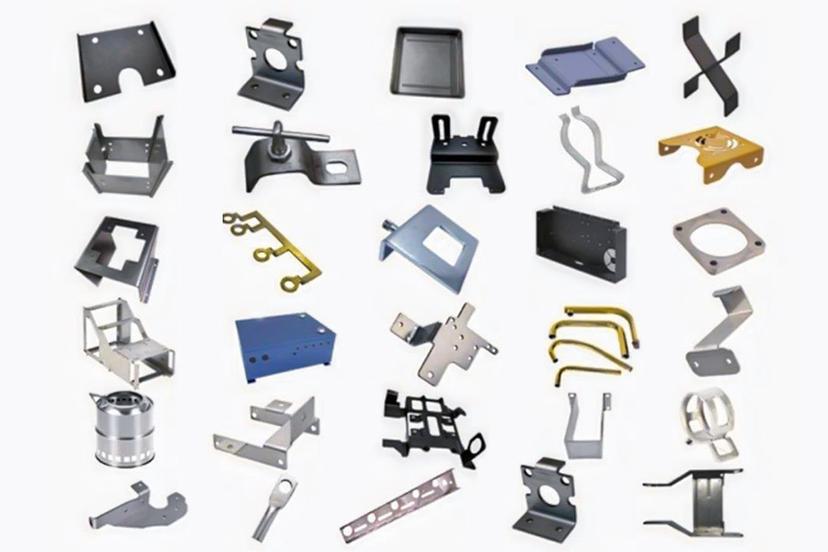Sheet metal, as an important branch of metal fabrication, focuses on a series of precise and complex fabrication of metal sheets to meet the diverse needs of furniture from simple components to complex structures. From automobile manufacturing to electronic equipment and aerospace manufacturing, the flow chart ofsheet metal fabricationis there. The diversity and flexibility of its technology provide solid support for the birth of countless products. When we discuss sheet metal fabrication in depth, we have to mention its rich and diverse processing types. These types not only cover all aspects from raw material preparation to finished product fabrication, but also reflect the continuous progress and innovation of sheet metal processing technology. Next, let us embark on an innovative journey of exploration, deeply analyze the varioustypes of sheet metal fabrication, and feel the beauty of craftsmanship and the power of technology behind it.
What is Sheet Metal Fabrication?
Sheet metal fabricationis a metal processing and forming process. It mainly uses metal sheet materials with a thickness of less than 6mm to produce parts, components or structural parts through a series of cold fabrication processes (such as cutting, bending, stamping, welding, surface treatment, etc.) . Products made ofsheet metalare widely used in automobiles, aerospace, electronic equipment, construction, medical equipment, communications, electronic appliances and other fields, such as car casings, computer cases, mobile phone metal parts, etc.

What Are the Different Types of Sheet Metal Fabrication?
1.Cutting
Cutting is the first step insheet metal fabrication, the purpose is to cut the metal sheetinto the required shape and size. Common cutting methods include:
- Laser cutting: Using a high-energy laser beam to melt or vaporize material to create a cut. This method is very fast and precise and works on sheet metal of various thicknesses and materials.
- Plasma Cutting: Creating a cut by creating an electrical channel of extremely hot ionized gas (plasma) that melts material. Plasma cutting is suitable for thicker sheet metal and cuts faster, but may require more post-processing to clean up the cut edges.
- Waterjet Cutting: Using an extremely high-pressure water jet (sometimes mixed with an abrasive) to cut materials. This method is suitable for cutting smaller thickness metal sheets, especially when the heat affected zone needs to be avoided. Stamping Cutting: Cutting using a shaped metal tool called a die. The mold is forced intothe metal sheet at high speed to perforate the metal sheet.Dies of standard shapes (round, square, rectangular) are typically used, but custom tools can also be made to stamp more complex shapes.
- Shearing: Cutting along a straight line between two cutting edges.
- Blanking: A cutting operation performed in one step along a closed contour to produce the desired part.
2.Bending
Bending is a key step in turning sheet metal into the desired shape. Common bending methods include:
- Using a Brake: A brake (also called a press brake) is a common tool for bending sheet metal. Precise bends can be achieved by adjusting the brake parameters such as pressure, speed and angle.
- Press: Presses can also be used tobend sheet metal. Similar to brakes, by adjusting the parameters of the press, the shape and accuracy of the bend can be controlled.
During the bending process, the springback and bending allowance of the metal sheet also need to be considered. Springback is the phenomenon where sheet metal returns to its original shape after bending, and bend allowance is the extra material set aside to compensate for springback and dimensional changes.
3.Forming
Forming is the process of transforming sheet metalinto the final shape of the desired product. Common forming methods include:
Stamping: Using dies and pressure to stamp sheet metal into the desired shape. Stamping is an efficient forming method suitable for high-volume production.
Rolling: Pressing sheet metal into the desired shape through rollers. Rolling is often used to make long or tubular products.
4.Welding
Welding is a critical step in joining sheet metal partstogether. Common welding methods include:
- Gas welding: Using a gas flame to melt metal and join parts. Gas welding is suitable for thinner sheet metal and smaller parts.
- Manual arc welding: Using an electric arc to melt metal and join parts. Manual arc welding is suitable for sheet metal of various thicknesses and materials.
- Gas-shielded welding: Welding performed under gas protection to prevent metal oxidation and contamination. Gas shielded welding is commonly used in automotive sheet metal and other applications where high-quality welding is required.
For specific materials, such as aluminum sheet metal and galvanized sheet metal, appropriate welding methods and welding materials need to be selected to ensure welding quality and strength. Aluminum sheet metal has a lower melting point and higher thermal conductivity, while galvanized sheet metal increases the complexity of welding due to the presence of a zinc layer. The main welding methods commonly used foraluminum sheet metalandgalvanized sheet metalare:
(1)TIG welding:TIG welding is a high-precision welding method suitable for weldingaluminum sheet metalandgalvanized sheet metal. It uses an inert gas (such as argon) shield and a tungsten electrode to melt the metal, resulting in a high-quality weld. Before welding, special cleaning solvents need to be used to clean the surfaces ofaluminum sheet metalandgalvanized sheet metalto remove oil and dust.
(2)MIG welding :MIG welding is usually used to weld thicker plates, and is also suitable for welding aluminum sheet metal and galvanized sheet metal. It uses aluminum welding wire and gas shielding to melt aluminum and galvanized sheet metal. Before welding, the surfaces of aluminum sheet metal and galvanized sheet metal also need to be cleaned, and pretreatment agents should be used to improve welding quality and strength.
③Pressure welding:Pressure welding is a method of bonding atoms between two workpieces in a solid state under pressurized conditions. Common pressure welding processes include resistance butt welding, friction welding, diffusion welding and explosion welding. For the welding of aluminum sheet metal and galvanized sheet metal, friction welding may be an ideal welding method because the base material does not melt, the heating range is narrow, the cooling rate is fast, and the joint is not easily oxidized.
④Arc fusion brazing:Arc fusion brazing is another method suitable for welding dissimilar metals such as aluminum and steel. This method requires attention to control the growth of the iron-aluminum intermetallic compound layer at the welding interface, because an excessively thick intermetallic compound layer will lead to a decrease in the mechanical properties of the joint.
5.Assembly
Assembly is the final step in assembling manufactured sheet metal parts into a finished product. The assembly process may include bolting, riveting, welding or other joining methods. During the assembly process, it is necessary to ensure precise fit and firm connection between parts to meet the performance and usage requirements of the product.

What Are the Common Materials Used in Sheet Metal Fabrication?
There are a variety of alloys and sheet metal forms that are used in manufacturing and processing. Listed below are some ofthe most commonly used sheet metal materials and their properties.
| Material | Advantages |
| Cold rolled sheet (SPCC) | It has stable thickness and excellent processing performance, is easy to form and cut, and is suitable for the production of various sheet metal products. |
| Galvanized steel sheet (SECC) | It has excellent electroplating performance and corrosion resistance, especially in humid environments. It is suitable for occasions where rust prevention and aesthetics are required. |
| Stainless steel | Excellent corrosion resistance, high temperature resistance and aesthetic properties, high strength, not easy to deform, widely used in kitchenware, medical equipment, construction and other fields |
| Aluminum | It has light specific gravity, corrosion resistance, good formability, easy processing and welding, and is suitable for the production of various light sheet metal products. |
| Copper | Excellent electrical conductivity, thermal conductivity and corrosion resistance, suitable for specific occasions requiring electrical conductivity, thermal conductivity or corrosion resistance |
| Mild steel | Mild steel has low carbon content, which makes it good flexibility, easy to process and form, and has good weldability. It is suitable for various welding processes and can meet the welding needs in sheet metal manufacturing. The manufacturing cost is relatively low, and it has It is beneficial to reduce the overall cost of sheet metal products. |
How Does the Sheet Metal Fabrication Process Work?
Step 1: Design and prototype using CAD software
Use computer-aided design (CAD) software to perform detailed design of sheet metal parts based on customer needs and project requirements. The size, shape, material, thickness and subsequent processing and assembly requirements of the sheet metal parts need to be considered during the design process.
Verify and modify the design throughrapid prototyping technology (such as 3D printing)or hand-made models to ensure that the design meets actual needs.
Step 2: Select materials based on project requirements
Select the appropriate material from a variety of sheet metal materialsbased on project requirements. Common sheet metal materials include cold-rolled sheets, galvanized steel sheets, stainless steel, aluminum, etc. When selecting materials, factors such as material strength, corrosion resistance, processing performance, and cost need to be considered. After determining the materials, proceed with material procurement. Ensure that purchased materials meet design requirements and have corresponding quality certification documents.
Step 3: Cut, Bend, and Shape the Metal into Shape
Use equipment such as laser cutters, shears, or punches to make precise cuts of materials. Cutting accuracy and edge quality need to be ensured during the cutting process. Next, equipment such as a bending machine, plate rolling machine or mold is used to bend and shape the cut material. During the molding process, the bending angle, bending radius and forming accuracy need to be controlled.
Step 4: Weld and Assemble Parts
Use welding equipment (such as TIG welding, MIG welding, resistance welding, etc.) to weld sheet metal parts. During the welding process, welding seam quality, welding strength and welding deformation control need to be ensured. Assemble the welded parts to form a complete sheet metal part. During the assembly process, it is necessary to ensure the fit accuracy and assembly quality between parts.
Step 5: Finishing operations such as painting, powder coating and polishing
Surface treatment of sheet metal parts, such as sandblasting, rust removal, pickling, etc., to improve surface quality and adhesion.
Sheet metal parts are painted or powder coated according to customer requirements. Painting and powder coating can protect sheet metal parts from corrosion and wear while improving aesthetics. Polish and sand sheet metal parts to improve surface finish and gloss.

Why is Sheet Metal Fabrication Important in Manufacturing?
Sheet metal fabrication includes a variety of techniques that offer many benefits. The final parts have uniform wall thickness with remarkable mechanical properties. The following are some of the major advantages of sheet metal fabrication
1.Accuracy and Efficiency
The accuracy and efficiency of sheet metal fabrication are top-notch. It is suitable for producing both prototypes and end-use parts. Furthermore, it is critical to understand that most sheet metal techniques are automated. The use of CAD software and CNC machining eliminates human errors. As a result, the final products usually have few or no deformations.
2.Versatility
The sheet metal fabrication process uses an array of techniques and tools. This makes it easy to choose the most suitable method for your project. Furthermore, metal parts fabrication does not limit the materials one can use. There are a thousand and more compatible metals. However, the application of the final part will influence the material you use.
3.High Capacity Production at Low Cost
With sheet metal fabrication, one can achieve a production capacity that is equal to the market demands. Though the initial cost may be high and the time of setting up may be long, it gets better when production begins. The more the parts produced, the more money one saves.
4.Manufacturing of Lightweight Components
Sheet metal fabrication produces lightweight yet durable parts. The excellent light-weight-to-strength ratio makes them useful in automotive and aerospace part manufacturing. Ultimately, it reduces manufacturing costs and improves fuel efficiency.
5.Custom-Built Designs
Sheet metal fabrication can be used to come up with innovative designs to build customized and unique parts. It is flexible and easily transforms metal sheets into personalized and aesthetically pleasing parts. The metal sheet fabricator can come up with innovative ideas and produce functional customized products.
Why Choose Longsheng’s Sheet Metal Fabrication Services?
At Longsheng, we are not only proficient in the various skills mentioned above, but we have a professional technical team that can provide leadingsheet metal fabrication servicesto manufacture high quality parts for you at very competitive prices. As an ISO 9001:2015 certified company, we focus on the construction of quality management system to provide customers with reliable service.
Our team of experts has the experience to perform DfM (Design for Manufacturability) analysis to improve your design. We are not only a manufacturer, but also a partner, committed to providing full support and professional advice to our customers to ensure that the design can reduce manufacturing costs while still meeting high quality standards.
If you have a design model that needs to be manufactured,please upload it to us immediately and we will provide you with an immediate quote. Choose Longsheng, choose a quality, high technical level, cost-effective sheet metal fabrication partner, let us work together to create outstanding parts for your project to achieve greater success.
FAQs
1.What are the types of metal fabrication?
Metal fabrication mainly includes processes such as cutting, bending, forming and assembly. Cutting is the basic step in metal processing, which is used to cut metal materials into required shapes and sizes; bending is the process of bending metal materials according to a certain angle or shape; forming: passing metal materials through molds or other tools, The process of plastically deforming it to obtain the desired shape and size; Assembly: It is the process of combining multiple metal parts through welding, riveting, bolting, etc. to form a complete product.
2.What are the methods of sheet metal fabrication?
Sheet metal fabrication is an important branch of metal processing, mainly fabrication metal sheets. Commonly used sheet metal processing methods include: Laser cutting: Laser cutting is characterized by its high precision, high efficiency, and suitability for complex shape cutting; Bending: using equipment such as CNC bending machines to bend metal sheets into the desired shape; welding: is a key technology for connecting multiple sheet metal components. Commonly used welding methods include argon arc welding, spot welding and laser welding.
3.What are the different types of sheet metal?
Metal sheets are important raw materials in metal processing and can be divided into many types according to their composition and uses:① Aluminum plate: It has good electrical conductivity, thermal conductivity and corrosion resistance, and is light in weight and high in strength. It is widely used in aerospace, automobile manufacturing, construction and other fields. ② Stainless steel: It has excellent corrosion resistance and high temperature resistance and is widely used in food processing, medical equipment, chemical equipment and other fields. ③ Galvanized steel: By plating a layer of zinc on the surface of the steel plate, the corrosion resistance and service life of thesteel plateare improved. It is widely used in construction, transportation, home appliances and other fields.
4.What are the 3 metal fabrication techniques?
Cutting, bending, and welding are the three core technologies in metal fabrication : Cutting: It is the first step in metal manufacturing and is used to cut raw materials into required shapes and sizes. Bending: By changing the shape of metal materials to make them conform to the requirements of product design. Welding: It is a key technology for connecting metal parts. Through welding, multiple parts can be combined together to form a complete product structure.
Summary
Sheet metal fabrication is an important metal sheet fabrication technology, covering various types such as bending, forming and assembly. These types of processes not only create complex shapes and structures, but also meet a variety of design and functional needs. With the continuous advancement of science and technology and the growth of market demand, the sheet metal fabrication industry will continue to grow, injecting greater impetus into the innovation and development of the industry.
Disclaimer
The content on this page is for reference only. Longsheng does not make any express or implied representation or warranty as to the accuracy, completeness or validity of the information. No performance parameters, geometric tolerances, specific design features, material quality and type or workmanship should be inferred as to what a third party supplier or manufacturer will deliver through the Longsheng Network. It is the responsibility of the buyer seeking a quote for parts to determine the specific requirements for those parts.Please contact us for more information.
Longsheng Team
This article was written by multiple Longsheng contributors. Longsheng is a leading resource in the manufacturing sector, withCNC machining,sheet metal fabrication,3D printing,injection molding,metal stamping, and more.






